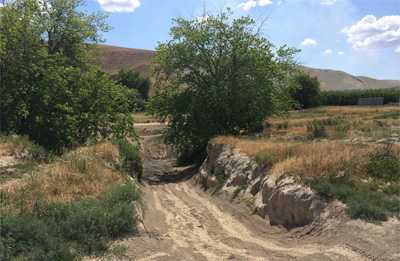AMD Projects: Mapping the Range of Valley Fever in the U.S.
Using whole genome sequencing to investigate the expanding geographic range of Coccidioides in the state of Washington

The fungus Coccidioides lives in dry, dusty soil in certain areas of the United States.
Coccidioidomycosis, a serious fungal infection also called valley fever, affects thousands of people every year when they inhale the microscopic fungus Coccidioides. The fungus is found in dry, dusty soil and other parts of the environment. In the past, scientists believed that this fungus lived only in the southwestern United States and parts of Latin America. That changed when public health officials identified three people in the south-central region of Washington State with valley fever between 2010 and 2011. Those three people had not traveled recently outside the region.
When investigators looked into the Washington cases, they suspected that one person had been infected during an ATV accident. Whole genome sequencing (WGS) demonstrated that fungal samples from the patient and the soil near the ATV crash site were the same, proving the source of the infection. Since then, several more cases of valley fever have been found in humans and animals in south-central Washington.
CDC has been developing new tools that make it faster and easier to detect Coccidioides in the environment. These tools include culture-independent real-time polymerase chain reaction (PCR) of soil and methods for detecting the fungus in dust.
Whole genome sequencing of additional samples revealed that the Washington fungal strains represent a distinct genetic group, different from the fungal strains seen in southwestern areas like California or Arizona. This brought up many questions for investigators: How widespread is Coccidioides in Washington? How did it get there? How long has it been there? Is it also in Oregon and other neighboring states with similar dry, dusty soil composition?
CDC is using advanced molecular detection (AMD) methods, including WGS, on patient and soil samples to answer these questions. Combined with other laboratory and epidemiologic data, this information will allow CDC scientists to determine where a person was most likely infected with the fungus, how the strains are related, and which geographic areas could pose a risk for future infection. Work performed as part of this project will give public health officials a better understanding of the geographic distribution of Coccidioides. This information is essential for raising awareness about Valley fever among healthcare providers, local residents, and others, such as construction workers, farmers, and workers who come into close contact with dry, dusty soil in these parts of the United States.
2017 Project Update
Since this project began, researchers confirmed that Coccidioides exists in the soil of two counties in southeastern Washington. Combined with other laboratory and epidemiological data, this information allows CDC scientists to determine where a person was most likely infected, how the strains are related, and which geographic areas could pose a risk for future infection. Work done as part of this project gives public health officials a better understanding of the geographic distribution of Coccidioides. This information is essential for raising awareness about Valley fever among healthcare providers and people who come into close contact with dry, dusty soil in these parts of the United States.
- Page last reviewed: March 27, 2017
- Page last updated: March 27, 2017
- Content source:


 ShareCompartir
ShareCompartir